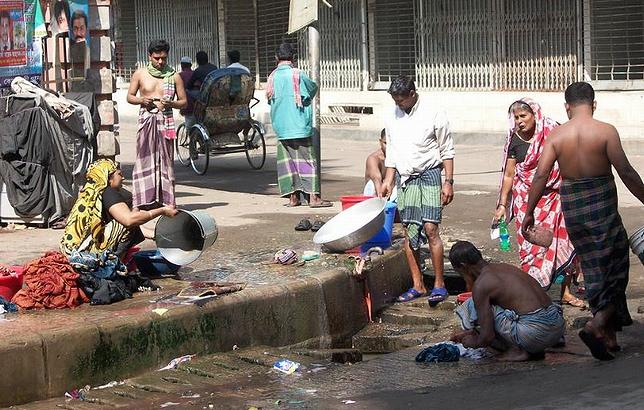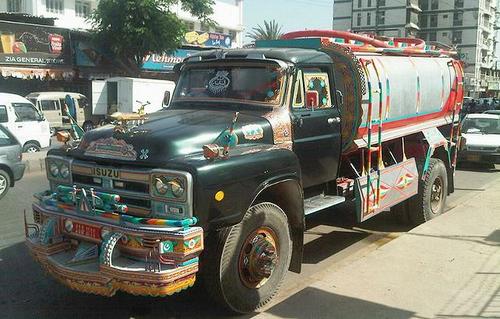Urban Water Crisis Grips Global South

Washing and drinking without piped water on the streets of Dhaka, Bangladesh, February 15, 2013 (Photo by David Brewer) Creative Commons license via Flickr.
By Sunny Lewis for Maximpact
MANCHESTER, UK, February 20, 2020 (Maximpact.com News) – Roughly half of all households in 15 large cities in the global south lack access to piped utility water, affecting more than 50 million people, finds a report by University of Manchester researchers. Access is lowest in the cities of sub-Saharan Africa, where only 22 percent of households receive piped water.
Of those households that did have access to piped water, the majority received intermittent service, the researchers learned. In the city of Karachi, Pakistan, the city’s population of 15 million received an average piped water supply only three days a week, for less than three hours each day.

An ornamented water tanker travels through Karachi, Pakistan, March 18, 2013 (Photo by No Real Name Given) Creative Commons license via Flickr.
These findings add to data from the World Resources Institute’s (WRI) Aqueduct tool, which recently found that by 2030, 45 cities with populations over three million could experience high water stress.
The research, detailed in the report “Unaffordable and Undrinkable: Rethinking Urban Water Access in the Global South” shows that even in some places where water sources are available, water is not reaching many residents.
Some cities, like Dar es Salaam in Tanzania have relatively abundant supplies, yet daily access to clean, reliable and affordable water continues to be problematic for many residents.
“Decades of increasing the private sector’s role in water provision has not adequately improved access, especially for the urban under-served,” said Diana Mitlin, lead author, professor of global urbanism at The Global Development Institute at The University of Manchester.
“Water is a human right and a social good, and cities need to prioritize it as such,” declared Mitlin.
Humanity’s thirst for freshwater has more than doubled since the 1960s, keeping pace with growing populations and economies, Betsy Otto and Leah Schleifer of the World Resources Institute blogged earlier this month.
“One-quarter of the world now faces extremely high water stress, where more than 80 percent of the available supply is withdrawn every year,” wrote Otto and Schliefer.
While agriculture and industry withdraw the overwhelming majority of the world’s freshwater – 70 percent for agriculture and 19 percent for industry – demand from households is also rising “precipitously,” they wrote. New data from WRI’s Aqueduct platform shows that domestic water demand grew 600 percent from 1960-2014, at a faster rate than any other sector.
Demand for water used to grow crops and livestock grew by more than 100 percent in the last century, while industrial water demand more than tripled, due to rising demand for electricity, fuel, and water-intensive goods like textiles.
Over the last century, the world’s population grew by more than four billion, contributing to the six-fold growth in municipal water use. More people, more homes and growing cities require more water than ever before.
“We must secure water for the 2.1 billion people who lack accessible, safe drinking water, while using this resource more efficiently to prevent crises and reduce water stress,” wrote Otto and Schliefer.
Analysis in the University of Manchester report showed that alternatives to piped water, like buying from private providers that truck water in from elsewhere, can cost up to 25 percent of monthly household income and is 52 times more expensive than public tap water.
Across all 15 cities, approximately 58 percent of households had access to piped water, the study shows.
In Latin American cities, 97 percent of households received water piped to their dwelling or yard, but there was notable variation within each geographic region. For example, in Cochabamba, Bolivia as many as 20 percent of households relied on tanker trucks.
In Asia, Dhaka, Bangladesh had the highest percentage of households with piped water, 95 percent, but much of it is piped from
underground reservoirs or storage tanks, and households must use hand or electric pumps to obtain it. This water is also a mix of utility water and groundwater. In Karachi, Pakistan, 25 percent of households received their water from tanker trucks, and 34 percent received it from small vendors or used bottled water.In the two Indian cities, households that did not have water piped to their premises relied on surface water, groundwater, and rainwater. In Mumbai, for example, eight percent of households relied on surface water, groundwater, and rainwater.
Global indicators used for the Millennium Development Goals and Sustainable Development Goals have largely underestimated this urban water crisis because they do not take into account affordability, intermittency or quality of water.
UNICEF and the World Health Organization reported in 2015 that more than 90 percent of the world’s population used improved drinking water sources. But Mitlin maintains that “improved” encompasses such a wide variety of sources, such as public taps, boreholes or wells that it fails to reflect the reality for individuals and families in today’s rapidly growing cities.
The question of whether water is affordable is not measured and while efforts have been made to increase water coverage, public authorities have paid little attention to affordability issues.
“Cities need to rethink how they view equitable access to water,” said Victoria Beard, co-author, fellow at WRI Ross Center for Sustainable Cities, and professor of city and regional planning at Cornell University.
“In many developing countries where urban residents lack access to safe, reliable and affordable water on a daily basis, these are the same countries that have made huge strides in guaranteeing universal access to primary education. Equitable access to water requires similar levels of political commitment,” Beard said.
“The solutions are not high tech,” she said. “We know what needs to be done.”
Investing in universal drinking water coverage in urban areas would cost US$141 billion over five years, according to the World Health Organization (WHO).
By comparison, total global economic losses from unsafe water and sanitation systems are estimated to be at least 10 times greater, at $260 billion per year during the same period.
The Manchester University researchers identified four specific actions that can improve water access.
- Cities and water utilities should extend the formal piped water network.
- Cities and water utilities need to address intermittent water service. If consumers know when water will be available, this reduces stress, saves time, avoids costs associated with wasted time, and discourages hoarding. It also helps businesses that rely on water to operate more efficiently and effectively
- Cities and water utilities need to pursue diverse strategies to reduce the cost of water for the lowest-income consumers. Strategies include providing subsidies for either free basic water or reducing the cost for small-scale purchases.
- Local and national governments need to support informal settlement upgrading to improve water access to the urban under-served in the short and medium terms. An estimated one in three urban dwellers in the global South live in informal settlements, which is where most low-income households are located. Informal settlement upgrading requires local governments to work with communities and nongovernmental organizations to install water and sanitation infrastructure.
“Without changes, the number of people receiving intermittent or poor-quality water will increase in the years ahead, due to rapid urbanisation, increased water scarcity resulting from climate change, and a general underinvestment in water infrastructure,” said Ani Dasgupta, global director of WRI Ross Center for Sustainable Cities.
“This will have huge costs for people and the economy,” Dasgupta said. “Cities must take actions now to guarantee all urban residents’ access to safe, reliable water in the future.”
The World Health Organization reports that the cost of investing in universal drinking water coverage in urban areas would be US$141 billion over five years. By comparison, the total global economic losses from the negative economic and environmental consequences of inadequate water and sanitation amount to $260 billion a year.